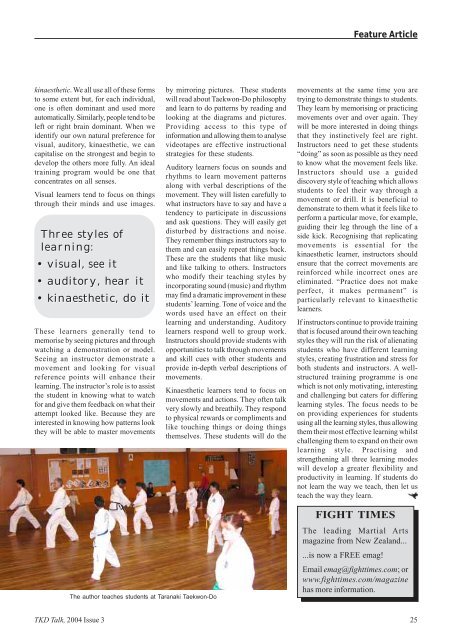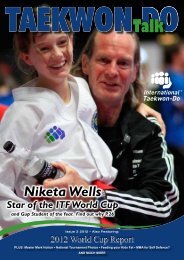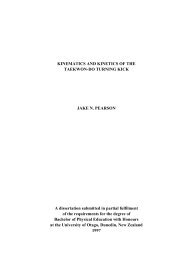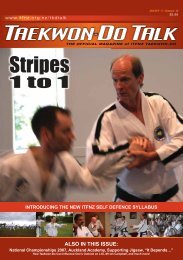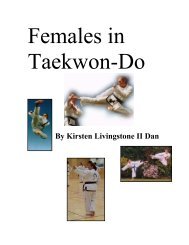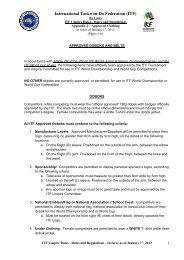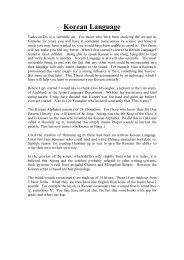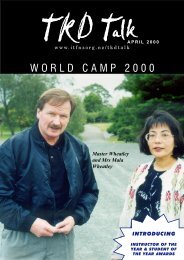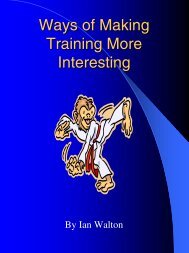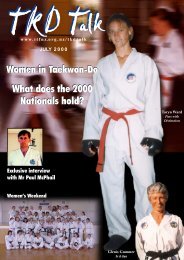The Official Magazine of ITFNZ Taekwon-Do - International Taekwon ...
The Official Magazine of ITFNZ Taekwon-Do - International Taekwon ...
The Official Magazine of ITFNZ Taekwon-Do - International Taekwon ...
Create successful ePaper yourself
Turn your PDF publications into a flip-book with our unique Google optimized e-Paper software.
Feature Article<br />
kinaesthetic. We all use all <strong>of</strong> these forms<br />
to some extent but, for each individual,<br />
one is <strong>of</strong>ten dominant and used more<br />
automatically. Similarly, people tend to be<br />
left or right brain dominant. When we<br />
identify our own natural preference for<br />
visual, auditory, kinaesthetic, we can<br />
capitalise on the strongest and begin to<br />
develop the others more fully. An ideal<br />
training program would be one that<br />
concentrates on all senses.<br />
Visual learners tend to focus on things<br />
through their minds and use images.<br />
Three styles <strong>of</strong><br />
learning:<br />
• visual, see it<br />
• auditory, hear it<br />
• kinaesthetic, do it<br />
<strong>The</strong>se learners generally tend to<br />
memorise by seeing pictures and through<br />
watching a demonstration or model.<br />
Seeing an instructor demonstrate a<br />
movement and looking for visual<br />
reference points will enhance their<br />
learning. <strong>The</strong> instructor’s role is to assist<br />
the student in knowing what to watch<br />
for and give them feedback on what their<br />
attempt looked like. Because they are<br />
interested in knowing how patterns look<br />
they will be able to master movements<br />
by mirroring pictures. <strong>The</strong>se students<br />
will read about <strong>Taekwon</strong>-<strong>Do</strong> philosophy<br />
and learn to do patterns by reading and<br />
looking at the diagrams and pictures.<br />
Providing access to this type <strong>of</strong><br />
information and allowing them to analyse<br />
videotapes are effective instructional<br />
strategies for these students.<br />
Auditory learners focus on sounds and<br />
rhythms to learn movement patterns<br />
along with verbal descriptions <strong>of</strong> the<br />
movement. <strong>The</strong>y will listen carefully to<br />
what instructors have to say and have a<br />
tendency to participate in discussions<br />
and ask questions. <strong>The</strong>y will easily get<br />
disturbed by distractions and noise.<br />
<strong>The</strong>y remember things instructors say to<br />
them and can easily repeat things back.<br />
<strong>The</strong>se are the students that like music<br />
and like talking to others. Instructors<br />
who modify their teaching styles by<br />
incorporating sound (music) and rhythm<br />
may find a dramatic improvement in these<br />
students’ learning. Tone <strong>of</strong> voice and the<br />
words used have an effect on their<br />
learning and understanding. Auditory<br />
learners respond well to group work.<br />
Instructors should provide students with<br />
opportunities to talk through movements<br />
and skill cues with other students and<br />
provide in-depth verbal descriptions <strong>of</strong><br />
movements.<br />
Kinaesthetic learners tend to focus on<br />
movements and actions. <strong>The</strong>y <strong>of</strong>ten talk<br />
very slowly and breathily. <strong>The</strong>y respond<br />
to physical rewards or compliments and<br />
like touching things or doing things<br />
themselves. <strong>The</strong>se students will do the<br />
movements at the same time you are<br />
trying to demonstrate things to students.<br />
<strong>The</strong>y learn by memorising or practicing<br />
movements over and over again. <strong>The</strong>y<br />
will be more interested in doing things<br />
that they instinctively feel are right.<br />
Instructors need to get these students<br />
“doing” as soon as possible as they need<br />
to know what the movement feels like.<br />
Instructors should use a guided<br />
discovery style <strong>of</strong> teaching which allows<br />
students to feel their way through a<br />
movement or drill. It is beneficial to<br />
demonstrate to them what it feels like to<br />
perform a particular move, for example,<br />
guiding their leg through the line <strong>of</strong> a<br />
side kick. Recognising that replicating<br />
movements is essential for the<br />
kinaesthetic learner, instructors should<br />
ensure that the correct movements are<br />
reinforced while incorrect ones are<br />
eliminated. “Practice does not make<br />
perfect, it makes permanent” is<br />
particularly relevant to kinaesthetic<br />
learners.<br />
If instructors continue to provide training<br />
that is focused around their own teaching<br />
styles they will run the risk <strong>of</strong> alienating<br />
students who have different learning<br />
styles, creating frustration and stress for<br />
both students and instructors. A wellstructured<br />
training programme is one<br />
which is not only motivating, interesting<br />
and challenging but caters for differing<br />
learning styles. <strong>The</strong> focus needs to be<br />
on providing experiences for students<br />
using all the learning styles, thus allowing<br />
them their most effective learning whilst<br />
challenging them to expand on their own<br />
learning style. Practising and<br />
strengthening all three learning modes<br />
will develop a greater flexibility and<br />
productivity in learning. If students do<br />
not learn the way we teach, then let us<br />
teach the way they learn.<br />
<strong>The</strong> author teaches students at Taranaki <strong>Taekwon</strong>-<strong>Do</strong><br />
FIGHT TIMES<br />
<strong>The</strong> leading Martial Arts<br />
magazine from New Zealand...<br />
...is now a FREE emag!<br />
Email emag@fighttimes.com; or<br />
www.fighttimes.com/magazine<br />
has more information.<br />
TKD Talk, 2004 Issue 3 25


